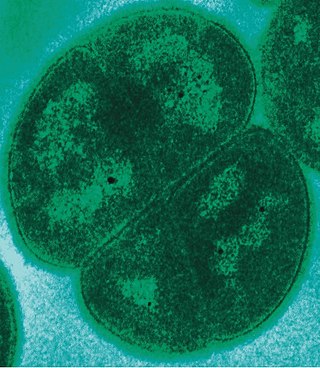
Nanoarchaeota is a proposed phylum in the domain Archaea that currently has only one representative, Nanoarchaeum equitans, which was discovered in a submarine hydrothermal vent and first described in 2002.

The Thermoproteota are prokaryotes that have been classified as a phylum of the Archaea domain. Initially, the Thermoproteota were thought to be sulfur-dependent extremophiles but recent studies have identified characteristic Thermoproteota environmental rRNA indicating the organisms may be the most abundant archaea in the marine environment. Originally, they were separated from the other archaea based on rRNA sequences; other physiological features, such as lack of histones, have supported this division, although some crenarchaea were found to have histones. Until recently all cultured Thermoproteota had been thermophilic or hyperthermophilic organisms, some of which have the ability to grow at up to 113°C. These organisms stain Gram negative and are morphologically diverse, having rod, cocci, filamentous and oddly-shaped cells.

Halomonadaceae is a family of halophilic Pseudomonadota.

The Thermodesulfobacteriota are a phylum of thermophilic sulfate-reducing bacteria.
In taxonomy, Ruegeria is a genus of the Rhodobacteraceae. This genus was formerly known as the marine Agrobacterium before they were reclassified in 1998. It bears in fact the name of Hans-Jürgen Rüger, a German microbiologist, for his contribution to the taxonomy of marine species of Agrobacterium.
The Gemmatimonadota are a phylum of bacteria established in 2003. The phylum contains two classes Gemmatimonadetes and Longimicrobia.
In taxonomy, Hyphomonas is a genus of the Hyphomonadaceae.
In taxonomy, Methanomethylovorans is a genus of microorganisms with the family Methanosarcinaceae. This genus was first described in 1999. The species within it generally live in freshwater environments, including rice paddies, freshwater sediments and contaminated soil. They produce methane from methanol, methylamines, dimethyl sulfide and methanethiol. With the exception of M. thermophila, which has an optimal growth temperature of 50 °C, these species are mesophiles and do not tend to grow at temperatures above 40 °C.
Halopiger is a genus of archaeans in the family Natrialbaceae that have high tolerance to salinity.
Natrinema is a genus of the Natrialbaceae.

Arcanobacterium is a genus of bacteria. They are gram-positive, non–acid fast, nonmotile, facultatively anaerobic, and non–endospore forming. They are widely distributed in nature in the microbiota of animals and are mostly innocuous. Some can cause disease in humans and other animals. As with various species of a microbiota, they usually are not pathogenic but can occasionally opportunistically capitalize on atypical access to tissues or weakened host defenses.

Deinococcus is in the monotypic family Deinococcaceae, and one genus of three in the order Deinococcales of the bacterial phylum Deinococcota highly resistant to environmental hazards. These bacteria have thick cell walls that give them Gram-positive stains, but they include a second membrane and so are closer in structure to Gram-negative bacteria. Deinococcus survive when their DNA is exposed to high doses of gamma and UV radiation. Whereas other bacteria change their structure in the presence of radiation, such as by forming endospores, Deinococcus tolerate it without changing their cellular form and do not retreat into a hardened structure. They are also characterized by the presence of the carotenoid pigment deinoxanthin that give them their pink color. They are usually isolated according to these two criteria. In August 2020, scientists reported that bacteria from Earth, particularly Deinococcus bacteria, were found to survive for three years in outer space, based on studies conducted on the International Space Station. These findings support the notion of panspermia, the hypothesis that life exists throughout the Universe, distributed in various ways, including space dust, meteoroids, asteroids, comets, planetoids or contaminated spacecraft.
Caldithrix is a genus of thermophilic and anaerobic bacteria, currently assigned to its own phylum.
Polynucleobacter is a genus of bacteria, originally established by Heckmann and Schmidt (1987) to exclusively harbor obligate endosymbionts of ciliates belonging to the genus Euplotes.
Pararhizobium is a genus of Gram-negative soil bacteria that fix nitrogen. Some species of Pararhizobium form an endosymbiotic nitrogen-fixing association with roots of legumes.
Ancalomicrobiaceae is a family of Alphaproteobacteria.
Emcibacteraceae is a family of bacteria.
The Temperatibacteraceae are a family of bacteria.
Pyrinomonas is a genus of bacteria, containing the only species Pyrinomonas methylaliphatogenes.





